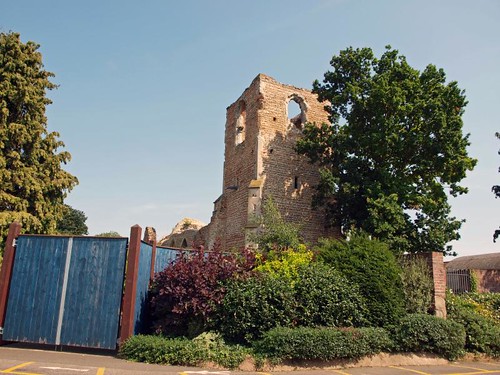The ruined church of ALL SAINTS comprises a nave with a north porch and a west tower. Nothing survives of the 13th- or early 14th-century church comprising chancel, nave, and bell tower, the nave of which collapsed in the 1380s or 1390s. The nave was rebuilt c. 1400, and the north aisle, whose arcade survives, and the west tower may have been built at the same time. There was an alabaster reredos behind the high altar in 1477, and the 'light beam' was painted in 1521. The church was repaired by John Swinnerton (d. 1616) as a private chapel; the chancel arch and north arcade were blocked with brick, and a brick north porch bearing the Swinnerton arms was added. By the early 18th century the church was 'utterly decayed', and has remained so.
I didn't expect to be able to see the church without having to pay for full admission to the zoo, which I would have been unwilling to do as I was on a churching trip rather than an entertaining the youngest trip, but was able to park the car and then walk back to the entrance where you get an OK view of the tower, top of the north arcade and chancel arch.
I may use some clubcard points on a summer trip.
ALL SAINTS. In the grounds of Stanway Hall. In ruins. An interesting building, consisting now only of tower and nave. The late C14 tower is of bands of flint and brick, the brick not being Roman any longer. Early in the C17 the N aisle was removed and replaced by brick windows, the N porch was added, and the chancel arch blocked and provided with a three-light brick window.
STANWAY. Its name means the stone-way by which the Romans went westward from Colchester, and its church has grown from a wayside chapel used by pilgrims. White Hart Farm close by goes back to the 15th century, and is said to have been a hospice for their shelter. Only the nave of the church is ancient, half of it being Norman, and the other half 15th century, with the porch. Roman bricks are in the angles of the walls and round the Norman windows, and a very narrow Norman doorway is made almost entirely of them. Between the chancel and the chapel is a 15th century arcade brought from a Colchester church; the font is the same age. A huge tiebeam supports the wooden bell-turret, and one of the Norman windows has modern glass of an angel blowing a trumpet, a charming memorial by four little children to their father.
A mile down the lane we come to the Tudor hall which treasures a handsome stone fireplace; and close to it stands the ruin of the original village church, deserted for centuries. Most of the tower and nave are 600 years old, and the roof is thought to have been torn down to supply the parliament men with material at the great siege of Colchester.
A mile down the lane we come to the Tudor hall which treasures a handsome stone fireplace; and close to it stands the ruin of the original village church, deserted for centuries. Most of the tower and nave are 600 years old, and the roof is thought to have been torn down to supply the parliament men with material at the great siege of Colchester.


No comments:
Post a Comment